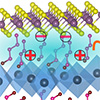 Assembling Lego-like 2D heterostructures can give rise to emergent properties and functionalities very different from the intrinsic characteristics of the constituents.
Assembling Lego-like 2D heterostructures can give rise to emergent properties and functionalities very different from the intrinsic characteristics of the constituents.
Jul 26th, 2022
Read more
 Nature creates layered materials like bone and mother-of-pearl that become less sensitive to defects as they grow. Now researchers have created, using biomimetic proteins patterned on squid ring teeth, composite layered 2D materials that are resistant to breaking and extremely stretchable.
Nature creates layered materials like bone and mother-of-pearl that become less sensitive to defects as they grow. Now researchers have created, using biomimetic proteins patterned on squid ring teeth, composite layered 2D materials that are resistant to breaking and extremely stretchable.
Jul 25th, 2022
Read more
 New research unveils the atomic-scale friction of a single tungsten asperity, or rough edge, in real time, showing atomic motion for the first time with electron microscopy.
New research unveils the atomic-scale friction of a single tungsten asperity, or rough edge, in real time, showing atomic motion for the first time with electron microscopy.
Jul 25th, 2022
Read more
 Liquid film can function as optical memory, enabling new architectural horizons for nanoscale neuromorphic computing.
Liquid film can function as optical memory, enabling new architectural horizons for nanoscale neuromorphic computing.
Jul 25th, 2022
Read more
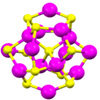 The smallest semiconductor composed of only 27 atoms, the Cd14Se13 cluster, has an interesting core-cage structure.
The smallest semiconductor composed of only 27 atoms, the Cd14Se13 cluster, has an interesting core-cage structure.
Jul 25th, 2022
Read more
 The challenges of implementing atomic and close-to-atomic scale manufacturing lie not only in the extreme small scale at which it can be machined, but also in the fundamental understanding of atomic interactions, which are based on the quantum theory rather than classical theory.
The challenges of implementing atomic and close-to-atomic scale manufacturing lie not only in the extreme small scale at which it can be machined, but also in the fundamental understanding of atomic interactions, which are based on the quantum theory rather than classical theory.
Jul 25th, 2022
Read more
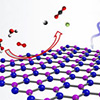 Cchemical engineers have improved their design for a light-powered catalyst that rapidly breaks down PFOA, one of the world's most problematic 'forever chemical' pollutants.
Cchemical engineers have improved their design for a light-powered catalyst that rapidly breaks down PFOA, one of the world's most problematic 'forever chemical' pollutants.
Jul 25th, 2022
Read more
 Chemists have discovered that pointy gold tetrahedrons self-assemble into 2D chiral superlattices. The structures could be useful metamaterials.
Chemists have discovered that pointy gold tetrahedrons self-assemble into 2D chiral superlattices. The structures could be useful metamaterials.
Jul 25th, 2022
Read more
 Scientists find a simple new way to describe the water-like movement of electrons in a novel type of semiconductor, which could pave the way for more efficient electronics.
Scientists find a simple new way to describe the water-like movement of electrons in a novel type of semiconductor, which could pave the way for more efficient electronics.
Jul 23rd, 2022
Read more
 Researchers have developed a new plasma-enabled process that could limit the proliferation of toxins from implants into a patient's bloodstream.
Researchers have developed a new plasma-enabled process that could limit the proliferation of toxins from implants into a patient's bloodstream.
Jul 22nd, 2022
Read more
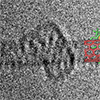 Researchers thread carbon nanotubes through coordination complexes and open a new field of opportunities for MINTs - mechanically interlocked carbon nanotubes.
Researchers thread carbon nanotubes through coordination complexes and open a new field of opportunities for MINTs - mechanically interlocked carbon nanotubes.
Jul 22nd, 2022
Read more
 A sprayable coating that prevents the surface spread of infection from bacteria and viruses, including COVID-19, over a sustained period has been developed by a team of researchers.
A sprayable coating that prevents the surface spread of infection from bacteria and viruses, including COVID-19, over a sustained period has been developed by a team of researchers.
Jul 22nd, 2022
Read more
 A recent study suggested that it is infinitely easier to make artificial graphene using C60 molecules called buckyballs. Only a uniform layer of these needs to be vapor-deposited onto gold for the gold electrons to take on the special graphene properties.
A recent study suggested that it is infinitely easier to make artificial graphene using C60 molecules called buckyballs. Only a uniform layer of these needs to be vapor-deposited onto gold for the gold electrons to take on the special graphene properties.
Jul 21st, 2022
Read more
 The technology could one day clear blockages in blood vessels or precisely target chemotherapy drugs to a tumor.
The technology could one day clear blockages in blood vessels or precisely target chemotherapy drugs to a tumor.
Jul 21st, 2022
Read more
 Scientists find a simple way to produce heterolayer coordination nanosheets, expanding the diversity of 2D materials.
Scientists find a simple way to produce heterolayer coordination nanosheets, expanding the diversity of 2D materials.
Jul 21st, 2022
Read more
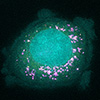 The findings of a large-scale screen could help researchers design nanoparticles that target specific types of cancer.
The findings of a large-scale screen could help researchers design nanoparticles that target specific types of cancer.
Jul 21st, 2022
Read more
 Assembling Lego-like 2D heterostructures can give rise to emergent properties and functionalities very different from the intrinsic characteristics of the constituents.
Assembling Lego-like 2D heterostructures can give rise to emergent properties and functionalities very different from the intrinsic characteristics of the constituents.















 Subscribe to our Nanotechnology News feed
Subscribe to our Nanotechnology News feed